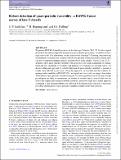Robust detection of quasi-periodic variability : HAWK-I mini survey of late-T dwarfs
Abstract
We present HAWK-I J-band light curves of five late-type T dwarfs (T6.5–T7.5) with a typical duration of 4 h and investigate the evidence for quasi-periodic photometric variability on intra-night time-scales. Our photometry reaches precisions in the range 7–20 mmag, after removing instrumental systematics that correlate with sky background, seeing and airmass. Based upon a Lomb–Scargle periodogram analysis, the latest object in the sample – ULAS J2321 (T7.5) – appears to show quasi-periodic variability with a period of 1.64 h and an amplitude of 3 mmag. Given the low amplitude of variability and presence of systematics in our light curves, we discuss a Bayesian approach to robustly determine if quasi-periodic variability is present in a light curve affected by red noise. Using this approach, we conclude that the evidence for quasi-periodic variability in ULAS J2321 is not significant. As a result, we suggest that studies which identify quasi-periodic variables using the false alarm probability from a Lomb–Scargle periodogram are likely to overestimate the number of variable objects, even if field stars are used to set a higher false alarm probability threshold. Instead we argue that a hybrid approach combining a false alarm probability cut, followed by Bayesian model selection, is necessary for robust identification of quasi-periodic variability in light curves with red noise.
Citation
Littlefair , S P , Burningham , B & Helling , C 2017 , ' Robust detection of quasi-periodic variability : HAWK-I mini survey of late-T dwarfs ' , Monthly Notices of the Royal Astronomical Society , vol. 466 , no. 4 , pp. 4250-4258 . https://doi.org/10.1093/mnras/stw3376
Publication
Monthly Notices of the Royal Astronomical Society
Status
Peer reviewed
ISSN
0035-8711Type
Journal article
Description
SPL is supported by STFC grant ST/M001350/1. BB acknowledges financial support from the European Commision in the form of a Marie Curie International Outgoing Fellowship (PIOF-GA-2013-629435). Based on observations made with ESO Telescopes at the La Silla Paranal Observatory under programme ID 090.C-0721. ChH highlights financial support of the European Community under the FP7 by the ERC starting grant 257431.Collections
Items in the St Andrews Research Repository are protected by copyright, with all rights reserved, unless otherwise indicated.

